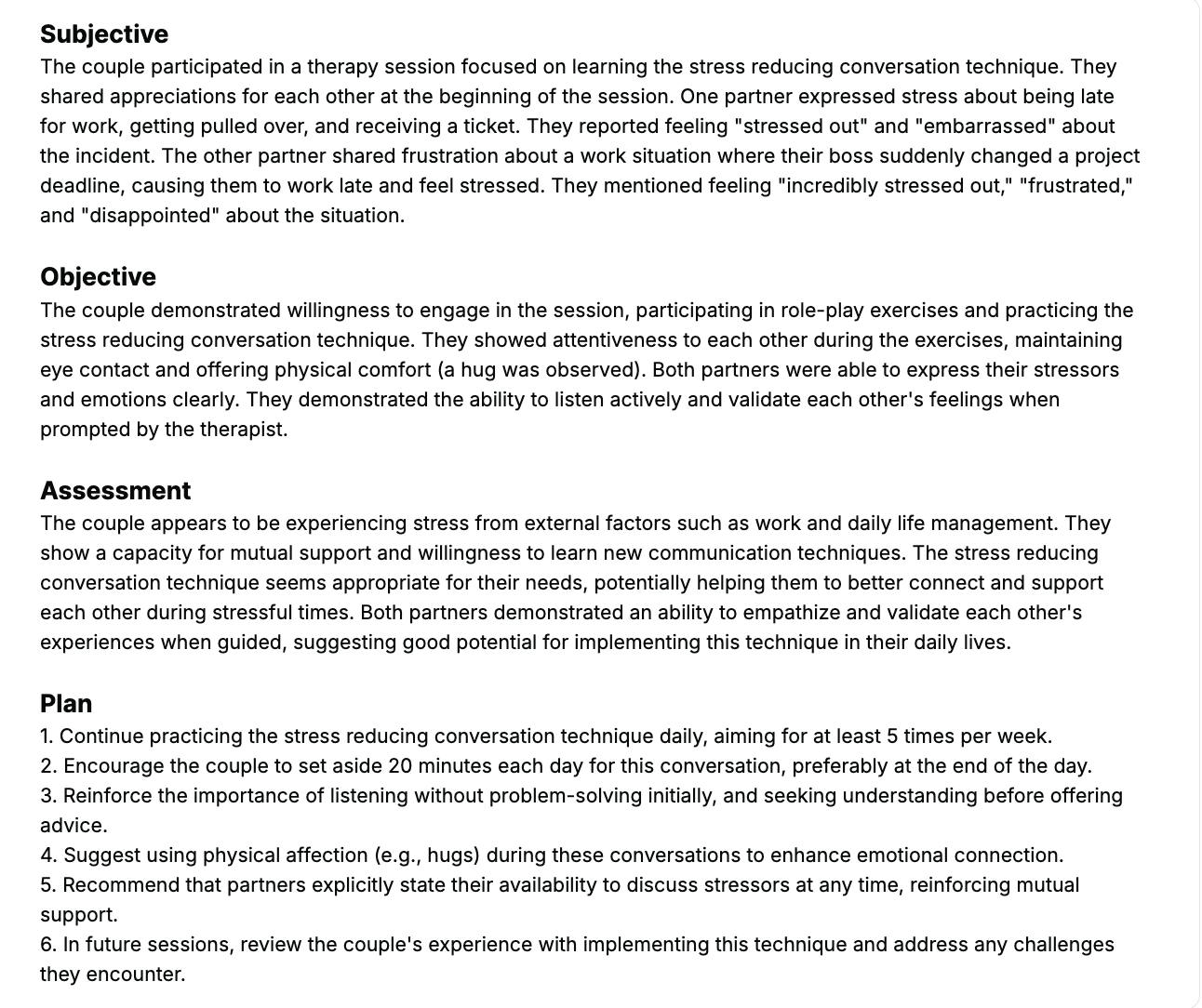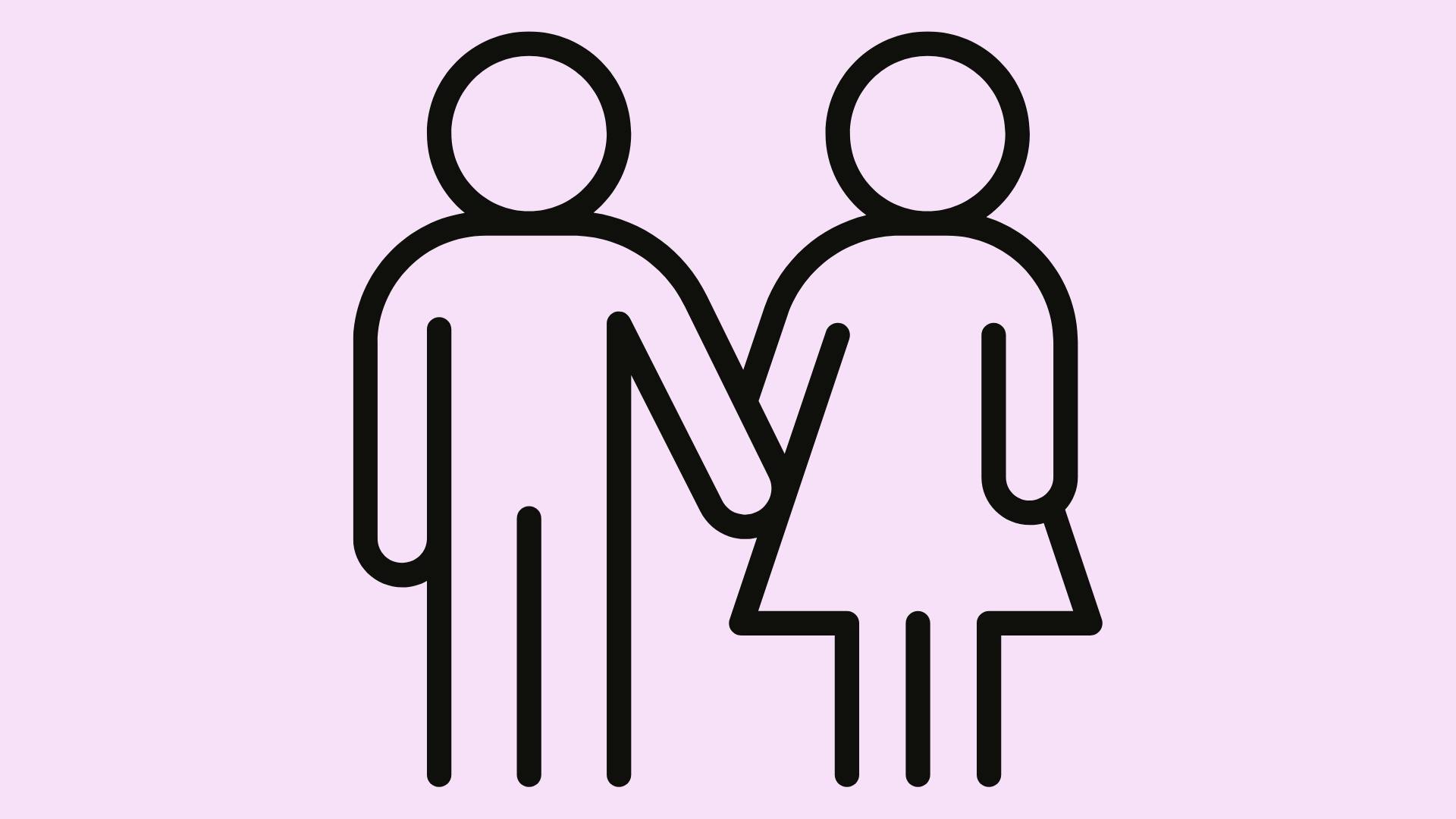Couples therapy isn’t just about two people- it’s about navigating layered histories, communication breakdowns, attachment wounds, and shared goals.
And for therapists, capturing that complexity in a couples therapy progress note template can be… well, daunting!
Whether you’re using SOAP, BIRP, DAP or GIRP notes or your custom note format, writing couples therapy notes demands nuance, neutrality, and a balance of emotional and behavioural observations.
Unlike individual therapy documentation, this process involves capturing interactions between two identified clients and ensuring accurate documentation of the couple's communication style and couple’s relationship.
This guide walks you through the documentation process using a structured couples therapy note template- complete with examples, actionable steps, and helpful tips for mental health providers, couples therapists, and private practice clinicians.
Why Use a Structured Couples Therapy Progress Note Template?
Progress notes in couples therapy serve as your clinical compass- guiding treatment decisions, protecting you legally, and supporting client progress.
For many clients, even agreeing to attend therapy is a huge step toward change.
Why It’s Essential:
- Improves clarity and consistency: Structured templates help keep your notes organized and focused on essential session content.
- Reduces documentation time: The right note template supports writing couples therapy notes more efficiently.
- Enhances legal and ethical compliance: Accurate documentation ensures interventions applied, safety concerns, and treatment goals are clearly recorded.
For many mental health providers, writing notes after couples therapy sessions feels like a time-consuming burden. The key is not to write more- but to implement a repeatable progress note template that allows for consistency, accurate documentation, and clinical depth across therapy sessions.
Key Components of a Good Couples Therapy Note Template
An effective couples therapy note template should accurately capture dual-client dynamics while ensuring legal compliance, therapeutic alignment, and concise documentation of significant events and specific interventions.
Well-crafted notes capture more than words- they track how clients listen actively and respond to one another over time.
1. Identifying Information
Include both clients’ names, session number, date, duration, CPT code, and therapist name. Also, clarify if insurance requirements apply to one partner or both. This section sets the foundation for SOAP notes and ensures administrative accuracy across sessions.
Example: “Session #4 with James and Maxine. 50-minute session billed under CPT Code 90847. James is listed as primary for insurance purposes.”
2. Presenting Issue / Session Focus
Highlight what the couple came to discuss, with emotional undertones. Avoid a transcript- summarise the couple’s presenting issue and themes emerging from previous notes and last session. This helps in tracking couple’s progress and refining treatment plans.
Example: “Explored trust issues stemming from past infidelity. Both clients appeared defensive at varying moments.”
3. Individual Client Observations
Observe each identified client’s mood, communication, and emotional state. This section is critical for documenting moments that may inform future individual therapy.
4. Couple Interaction Summary
This is where your clinical notes should reflect how the couple interacts- pursuer-withdrawer patterns, problem-solving strategies, conflict escalation, and moments of active listening or emotional repair. These dynamics are key in allowing therapists to assess relational growth.
Example: “Repeated criticism-defensiveness cycles emerged,” or “David acknowledged Sarah’s stress, allowing a softening moment.”
5. Therapeutic Interventions
List therapy tools and strategies used. Include methods like speaker-listener exercises, EFT enactments, Gottman techniques, or psychoeducation. Reflect how interventions applied link to broader treatment goals.
Example: “John acknowledged a pattern of shutting down when emotionally overwhelmed, which helped shift the conversation toward collaborative problem-solving.”
6. Progress Toward Treatment Goals
Was therapeutic progress made? Document observable changes in emotional regulation, improved problem solving, or increased empathy. Avoid vague terms like “minimal progress”—opt for specifics and achievable goals that illustrate forward movement.
Example: “Client stated they completed connection ritual homework; conflict discussion was less escalated than previous sessions.”
7. Risk or Safety Issues
Note signs of aggression, IPV history, or high reactivity. Document safety plans and your clinical decisions. These entries play a vital role in maintaining ethical therapy documentation.
8. Plan for Next Session
Tie today’s work to the next session. Include homework assigned, follow up areas, and themes to revisit. This creates a sense of structure in your therapeutic process and supports continuity.
Example: “Next session will explore unmet emotional needs beneath reactivity. Follow up on homework check-ins and sleep patterns.”
Couples Therapy Progress Note Template (SOAP Format)
Section | What to Include |
|---|---|
S: Subjective | Client stated concerns from each partner (e.g., “I feel disconnected when he shuts down.”) |
O: Objective | Observable behavior, mood, couple’s communication style, tone, and session dynamics |
A: Assessment | Therapist’s impression of relational dynamics, emotional shifts, and therapeutic process |
P: Plan | Interventions applied, homework assigned, treatment plans addressed, and focus for next session |
Sample Couples Therapy Note (Example)
Date: 03/15/2024
Session #: 8
Duration: 50 minutes
Clients: Sarah M. & David M.
CPT Code: 90847
Therapist: Dr. Johnson
S:
Sarah stated, “He never talks about how stressed he is-I just have to guess.”
David: “It’s easier to stay quiet than cause another fight.”
O:
Sarah tearful, anxious, hyperverbal. David flat affect, limited speech. Couple appeared emotionally disconnected.
A:
Pattern of pursue-withdraw observed. David acknowledged job-related anxiety for the first time. Sarah showed improved self-regulation during conflict discussion.
P:
- Intervention: Speaker-listener activity, somatic grounding, Gottman conflict repair language
- Homework: Nightly 10-minute connection ritual
- Plan: Assess emotional validation progress next session; follow up on Sarah’s sleep quality
Best Practices for Writing Couples Therapy Notes
- Focus on the Relationship: Couples notes should go beyond individual issues to highlight relational patterns.
- Use Neutral Language: Stay objective-document behavior, not judgment.
- Track Progress Across Sessions: Refer to previous sessions to show therapeutic progress.
- Document Client Engagement: Note whether clients follow up on assigned tasks or demonstrate growth.
- Stay Legally Sound: Accurate documentation protects both clients and clinicians in complex couples counseling cases.
Mistakes to Avoid When Writing Couples Therapy Notes
- Blurring individual voices: Be clear about which client said or did what—avoid ambiguity.
- Skipping session dynamics: Document how the couple interacts, not just what they say.
- Overusing generalisations: Replace vague terms like “some progress” with observable behaviour.
- Neglecting follow-up plans: Always outline the next session’s direction or homework.
- Failing to assess risk: If tension or escalation arises, document it and assess safety.
Automating Notes with Supanote
Why Therapists Use Supanote for Couples Notes?
Supanote offers AI-powered note templates tailored to therapy workflows- including couples sessions. It helps therapists document how the couple interacts, track progress, capture therapeutic process, and generate structured clinical notes fast.
The system prompts you with targeted questions, so you don’t miss key relational moments. It’s designed to streamline documentation, reduce admin, and support therapists across all treatment types- not just couples work.
The best thing about Supanote is, you can also create your customised template for your couple therapy sessions
If you are using a customised note template for your couple therapy sessions, don't forget to follow this plan:
- Begin with an adaptable skeleton focused on observations, interventions, client progress, and next session planning
- Align language with your modality, such as referencing the Four Horsemen in Gottman or attachment bids in EFT
- Test templates for 2–3 weeks and watch for repeated documentation gaps
Below is a sample Couples Therapy SOAP note written by Supanote.

Custom Notes That Reflect Your Approach
Create your own couples therapy progress note template inside Supanote and streamline your documentation flow.
Try it for Free Now!
FAQs: Couples Therapy Progress Notes
Q. Can I bill insurance for couples therapy sessions?
A. Yes, under one client’s name—document the identified client and note medical necessity.
Q. Should I write separate therapy notes for each partner?
A. Not usually. One note per session suffices unless legal context requires separation.
Q. What if one partner misses a session?
A. Document the session as individual therapy if only one client attends. Clarify shift in note.
Q. How do I know what to include from the session?
A. Focus on couple’s progress, interventions applied, and clinically relevant issues from the session.
Q. Can Supanote help with writing couples therapy notes?
A. Yes! Supanote supports SOAP notes and progress note templates with AI prompts for relational work.
Q. How do I document minimal progress?
A. Be specific: “Clients acknowledged pattern but were unable to apply tools consistently.”
Q. Should I reference last session in my note?
A. Yes, especially when tracking therapeutic progress or following up on treatment goals.
Q. Do templates work for all modalities?
A. Yes. Whether you use EFT, Gottman, or integrative models, a well-designed note template adapts.
Q. What if I forget key details from the session?
A. Complete notes soon after therapy sessions end. Supanote’s AI-generated prompts can help you recall significant events.
Q. What’s the reason couples choose therapy?
A. Usually for conflict resolution, emotional reconnection, or support with life transitions. Track progress accordingly.
Q. How do I write a couples therapy progress note?
A. Use a structured format like SOAP to document both clients' voices, their interaction, clinical insights, and interventions.
Q. How do I write a therapy progress note?
A. Include subjective reports, objective observations, therapist assessment, and your next steps.
Q. How do I measure progress in couples therapy?
A. Look for improved communication, emotional awareness, reduced conflict, and task follow-through.
Q. How do I help couples make progress?
A. Set achievable goals, listen actively, and use structured techniques like EFT or Gottman tools.
Q. How to write a therapy progress note?
A. Focus on subjective reports, objective observations, your clinical interpretation, and plans for the next session. A good note links session content to broader treatment goals.
Q. How to measure progress in couples therapy?
A. Track patterns over time: improved communication, reduced conflict, increased emotional responsiveness, or completion of assigned tasks. Supanote helps visualize this progress through organized documentation.
Q. How to make progress in couples therapy?
A. Create achievable goals, build emotional safety, listen actively, and apply techniques like EFT or Gottman interventions. Consistent documentation allows you to refine treatment plans session by session.
Resources for Further Reading
- Gottman Institute: Tools for Couples Therapy
- ICEEFT – Emotionally Focused Therapy Training
- APA Guidelines for Record Keeping
- CAMFT Documentation Guidelines
- Therapist Aid – Relationship Worksheets
Conclusion
Couples therapy notes don’t need to feel overwhelming. With a clear progress note template, structured sections, and AI tools like Supanote, documentation becomes a tool for growth- not just a task to check off.
Just track change, clarify patterns, and stay legally and clinically aligned.
Ready to try? 10 notes on us!
Login to your Supanote account and instantly access 10 free notes
Get it Now!
